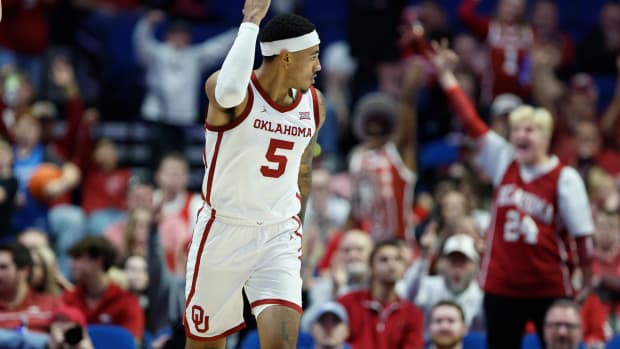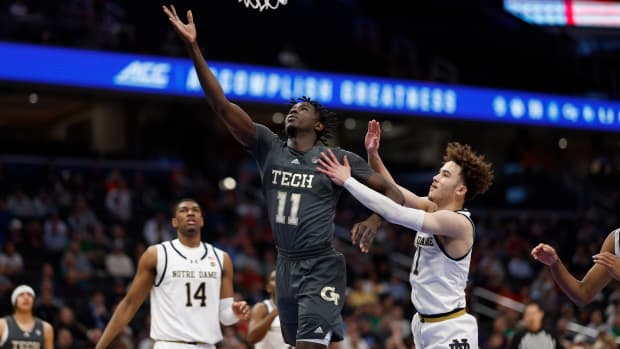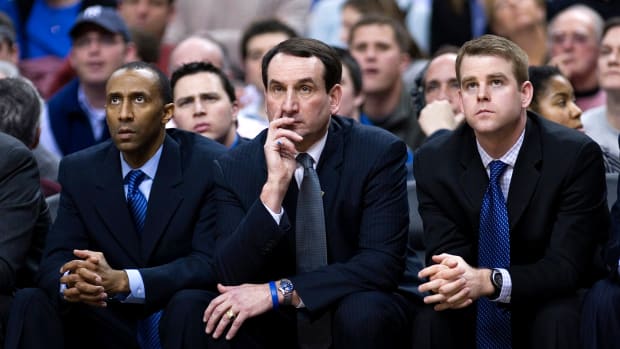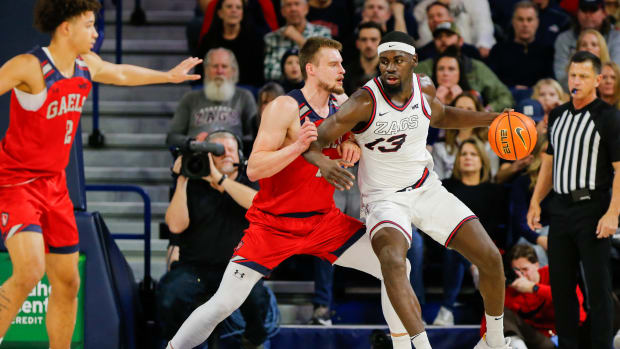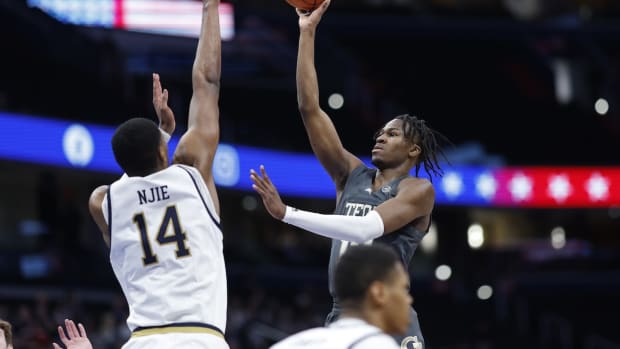Seth Davis: After 22 years at Sports Illustrated, farewell and thank you
A few years ago, I came upon a journal I had written shortly after my graduation from college. It recounted the summer of 1992, when I went with a few college buddies on a post-graduation romp through Europe. In the journal entry, I described a conversation the six of us were having on a beach in Greece. The topic: What is our ideal job? My answer: Senior writer for Sports Illustrated.
Notice I didn’t say writer for Sports Illustrated. I said Senior Writer for Sports Illustrated. I had studied the masthead for so long that I knew exactly what the editorial levels were: Reporter, then Writer-Reporter, then Staff Writer, then Senior Writer. Sports Illustrated was the ultimate dream for an aspiring sportswriter like me. I wasn’t just shooting for the top that day in Greece. I was shooting for the top of the top.
Today, I am writing my final article for Sports Illustrated after 22 years on the masthead. My position: Senior Writer. Absurd, isn’t it?
Way-Too-Early Top 25 rankings for the 2017–18 college basketball season
How many people have a chance to fulfill their ultimate dream? I have been blessed to do a lot of things in my journalism career, but wherever I go and whatever I will do, I will always be amazed and humbled that I have written so long for this incredible magazine. It’s all I ever wanted to do.
Given today’s cluttered media marketplace, it may be difficult for people (especially young people) to imagine that any publication, much less a printed one, could hold such sway. But when I was growing up, Sports Illustrated was the only place that was doing consistent, excellent longform sports journalism. I couldn’t wait for the issue to land in my mailbox each Thursday. Who was going to be on the cover? What stories were in the Table of Contents? I would read these terrific pieces and study the bylines. It was hard to imagine that there were actual people behind those names, crafting such magnificent stories that would be forever beyond my skills. I wanted to be like them.
The first Sports Illustrated writer I ever met was also my favorite: Alexander Wolff, who wrote so eloquently about college basketball. I was a senior at Duke, and Alex was there working on a profile of Mike Krzyzewski. I introduced myself to Alex and devoured his story when it was published.
A few months later, I was in Minneapolis covering the NCAA tournament for the Duke student newspaper when I met another staffer from Sports Illustrated named Tim Crothers. Tim, who had previously worked at the newspaper in Durham, North Carolina, was a Reporter. He told me he was there to collect quotes, notes and anecdotes to pass along to Alex Wolff, who would incorporate that information into his main story in next week’s magazine. Tim told me he was a “fact checker.” I was fascinated to learn that such a job existed. It gave me hope. I knew I would never write as well as Alex Wolff (and I still don’t), but I thought I might be able to learn how to check a few facts for him. Maybe that would be my way in?
Arizona coach Sean Miller eyes Final Four breakthrough
Two years later, I was covering high school sports in Connecticut for the New Haven Register when a co-worker put me in touch with a reporter/fact checker at the magazine named Ashley McGeachy. (She is now Ashley Fox, an NFL reporter for ESPN.) When I told Ashley I wanted to apply for a job there, she gave me two pieces of advice: Spell the name of the Chief of Reporters correctly (it was Stefanie, not Stephanie), and take a chance with your cover letter.
That was all I needed to hear. I used the computers at my newspaper to create a mock story “reporting” that I was applying to SI. The byline was Cove R. Letter. I mailed it with some of my clippings, and it was a hit. Stefanie called me a few weeks later and initiated the interview process that landed me a job as Reporter. Stefanie still works at Sports Illustrated. To this day, whenever I speak to her, my first words are always, “Thank you for hiring me.”
Stefanie’s decision sent me on this two-decades odyssey that was everything I dreamt it would be and more. As soon as I got there, I looked for every which way I could to get published. Back in that pre-internet Stone Age, SI produced special preview issues for various sports, giving entry-level reporters like me an opportunity to write articles—which I did for the college football, NFL and college basketball issues. I remember speaking on the phone with a soft-spoken junior at Wake Forest named Tim Duncan. In the wake of Kevin Garnett’s decision to go straight from high school to the 1995 NBA draft, I pitched a piece to the Scorecard folks predicting that that all of the top high school players in America would want to follow suit. One of the kids I interviewed on the phone for that item was Kobe Bryant, a rising senior at Lower Merion High School in Pennsylvania. Kobe confirmed that he was indeed hoping to make the same leap to the pros because “I want to get to the NBA before Michael Jordan gets too old.”
Face of a Nation: Bronson Koenig embracing prominent role among Ho-Chunk people
One of the first things I noticed about going from a mid-sized Connecticut newspaper to Sports Illustrated is that you got your phone calls returned more quickly. I distinctly remember then-Philadelphia 76ers coach John Lucas including his home phone number while leaving me a voicemail. That never happened to me in New Haven, I thought. My first road trip was to Villanova, where I interviewed Wildcats coach Steve Lappas in his office and watched him work with Kerry Kittles in practice. My first plane trip was to Utah, where I reported a scouting report on a Utes team that featured Keith Van Horn and Andre Miller. That was the trip where I ended up interviewing Utah’s portly coach, Rick Majerus, while he was standing buck naked in his room at the Salt Lake City Marriott. But that’s a story for another day.
Most of my time in those days was spent fact checking stories. The work could be tedious and unglamorous, but as I look back, I recognize that that was the period when I learned the fundamentals that carry me to this day. When a story landed on my desk, the first thing I would do was call the writer and ask, Where did you get this? Where did you get that? We had computers with publishing software, but most everything was done on paper. After I got assigned a story, I’d check it line by line with my trusty pencils. Stefanie taught me to underline facts to be checked with the red pencil and cross them off neatly when I confirmed them. If I needed to make a change, I would write it in blue pencil. As the story moved around the computer system to various editors, it would eventually land in my queue, and I would type in the changes and answer the editors’ questions. It was the best education I ever got.
The magazine closed each Monday so we would typically work past midnight Sunday night. The “bullpen,” as the fact checking group was known, was such fun back then. We were young kids doing what we loved and watching a ton of sports. It hardly felt like work (and still doesn’t). Around dinnertime, I would run home to my apartment in Greenwich Village so I could walk my Labrador retriever named Bailey. (I named him for George Bailey, Jimmy Stewart’s character in "It’s A Wonderful Life".) I brought Bailey into the office a few times to hang out. Everyone loved him, but late one Sunday night, I lost track of him and he wandered down the hall. A few minutes later I got word that he had urinated on a plant outside the Managing Editor’s office. The boss was a good sport about it, but that was the last time I brought Bailey with me to work.
Revisiting the remarkable legacy of John Wooden, the greatest coach of them all
I finally broke through in the summer of 1997. Based on my days covering high schools, I had noticed a sea change in the way basketball players were being recruited. The summer scene had gotten so big that the high school season was rendered basically irrelevant. I pitched a story to the editors I called “July Madness.” (And by “pitch,” I specifically recall writing up the idea in Microsoft word, printing out a couple dozen copies, and then walking around the halls and sliding it under editors’ doors. Like I said, the Stone Age.) The story was approved and I headed out to the Nike All-America Camp in Indianapolis. I asked other coaches I knew to let me know if they saw a really good player they had never heard of before. Karl Hobbs, who was an assistant at UConn, came up to me later that day and suggested I check out a kid from Arizona. I did, and when I spoke to the kid after the game, I was struck by how intelligent and articulate he was. His name was Richard Jefferson, and I instantly knew he would make me a great story. That story was published later that summer, putting my name in the sacred Table of Contents for the very first time.
Having graduated from Duke and covered high school basketball in New Haven, it was natural that I would gravitate toward college basketball. Mostly, though, I saw opportunity. The magazine had many good college basketball writers, but there was no one who was really trying to own the beat the way Peter King, say, owned the NFL. So I sank my teeth into college hoops, and when I finally knew more than the editors, I became a valuable asset. That allowed me to climb my way out of the bullpen, getting promoted to Writer-Reporter (the aforementioned Managing Editor, Bill Colson, called me down to his office to tell me the news) and then Staff Writer a few years later (he got me on my cell phone as I was leaving a practice at Seton Hall).
I was barely getting my stuff into the magazine when Time Warner launched a venture with its new partner, Turner Broadcasting, called CNN/SI. This was a 24-hour sports news network that was created before ESPNews. Part of the idea was that the network would use Sports Illustrated writers, but many of them were not interested in going on TV. I happily filled that void. I had done a lot of work for the student TV station at Duke and had always aspired to pursue that avenue. I got lots of repetitions behind the small anchor desk that was stationed in a hallway across from a robotic camera. In those days, CNN—not CNN/SI, but big CNN—aired a half-hour live show on Saturday mornings called “College Basketball Weekly.” I was a regular panelist. My TV work grew my skills and provided me with some exposure, and at one point the network asked if I might be interested in moving to San Francisco to work in their bureau there. But I loved New York and I loved writing for Sports Illustrated. I didn’t want to leave either one.
It wasn’t easy to get published. Each week, the Table of Contents held maybe a half-dozen stories, and if there were 40 writers on staff, the vast majority of them were far better than I was. I grinded as best I could, helping other writers report their stories and taking over the Inside College Basketball column at the back of the magazine. I loved being on the college hoops beat, which allowed me to do cool things like stay up all night with the Michigan State staff as they watched film two nights before the 2000 championship game.
As the internet became more important to the company, my work began showing up more and more on the website. That became even more true after I started working for CBS during the 2003-04 season. The network had invited me on for a segment during an hour-long Sunday show at the previous Final Four. They invited me back to work in the studio during the regular season, and to my great surprise, they kept inviting me right through the NCAA tournament. I’m still waiting for them to change their minds. I love the work I do for CBS and the people I do it with, but in my heart, in my DNA, I still think of myself as an ink-stained wretch.
And I never got tired of seeing my name in the Table of Contents, especially when the stories were truly meaningful. I wrote about a player at Illinois named Brian Cook, whose father, Norm, was a former NBA first-round draft pick who fell under the grips of paranoid schizophrenia. I wrote about the two young men who were featured in the documentary "Hoop Dreams," my second-favorite flick next to "It’s A Wonderful Life." I wrote about the disappearing act former USC guard Harold Miner, who has long dealt with Obsessive Compulsive Disorder, pulled after his NBA career flamed out. I wrote about former Kentucky and NBA guard Rex Chapman, who in recent years has overcome an addiction to opioids. I wrote about a Duke guard named Andre Dawkins who battled depression in the wake of his sister’s death in an automobile accident. I wrote about former USC coach George Raveling, who stood a few feet away from Martin Luther King when he delivered his “I Have a Dream” speech. When the speech was over, Raveling convinced King to hand him the papers that sat on his podium. Raveling still keeps those papers in a bank vault somewhere in California.
My favorite all-time article was also my shortest. It was from the years I spent on the golf beat. For our preview of the 2002 U.S. Open at Bethpage Black, the golf editor wanted a first-person piece based on our memories playing public golf courses. I decided to write about playing with my grandfather, who had died in 1996. Someone recently sent me that article over Twitter. It brought back a lovely memory, and it also called to mind the answer I give every time someone asks whether I like television or writing more: TV is more fun, but writing is more gratifying.
A few years ago, Sports Illustrated’s group editor, Paul Fichtenbaum, called to inform me of some minor piece of business that applied to Senior Writers. I told Paul that I was actually still a Staff Writer. He sounded surprised and said, “We’ll have to take care of that.” A few weeks later, my promotion was announced among many other items in a company-wide email. The dream of which I had spoken on that beach in Greece was officially fulfilled. Absurd, indeed.
Nothing great lasts forever, of course. On May 11, one of my editors called me to let me know that I was being let go as part of the latest round of cost-cutting. I was shocked but not surprised. These are challenging times for the industry, as we all know, and I had long surmised that it was only a matter of time before I got that call. You’re never quite ready when it happens, but as tough as it was for me to hear it—and as tough as it was to go home and relay the news to my wife—it ended up being one of the most wonderful experiences of my life. After news of my layoff broke later that day, I was bombarded with text messages, voicemails, emails, Twitter messages and the like from friends far and wide offering support. I was the proverbial Tom Sawyer showing up at his own funeral. I wish everyone could experience something like that at least once. Getting laid off also gave me the chance to show (as opposed to tell) my three young sons how we should deal with adversity. And it forced me to take inventory of my journey from that beach in Greece to that phone call, relishing one last time in the wondrous absurdity of it all.
How Bob McKillop recruited players from seven countries to Davidson
As to what that my future will entail, well, you guys know me: I dream big and plan bigger. I will continue my television work for CBS, CBS Sports Network and Big Ten Network, but I fully intend to keep writing. So as I leave this place after 22 years of employment that never felt like work, I want to signal a final clarion call: Reports of the death of sports journalism are greatly exaggerated. Technology may be advancing at warp speed, but one thing that will never change is the intense passion felt by sports fans. Where there is passion, there is curiosity. I fully believe that if you give fans good reporting, smart writing and a quality user experience, they will want to read your words as fast as you can write team. Not only do I believe that to be true, I intend to prove it.
So yes, I will be writing, somewhere. When I do, I’d like to think that it will end up in the hands of a young reader, and that his passion for journalism might be piqued. I’d like to imagine that perhaps he will check out the byline and wish he could be like me. But the truth is, I still want to be like him.
'Til we meet again…
